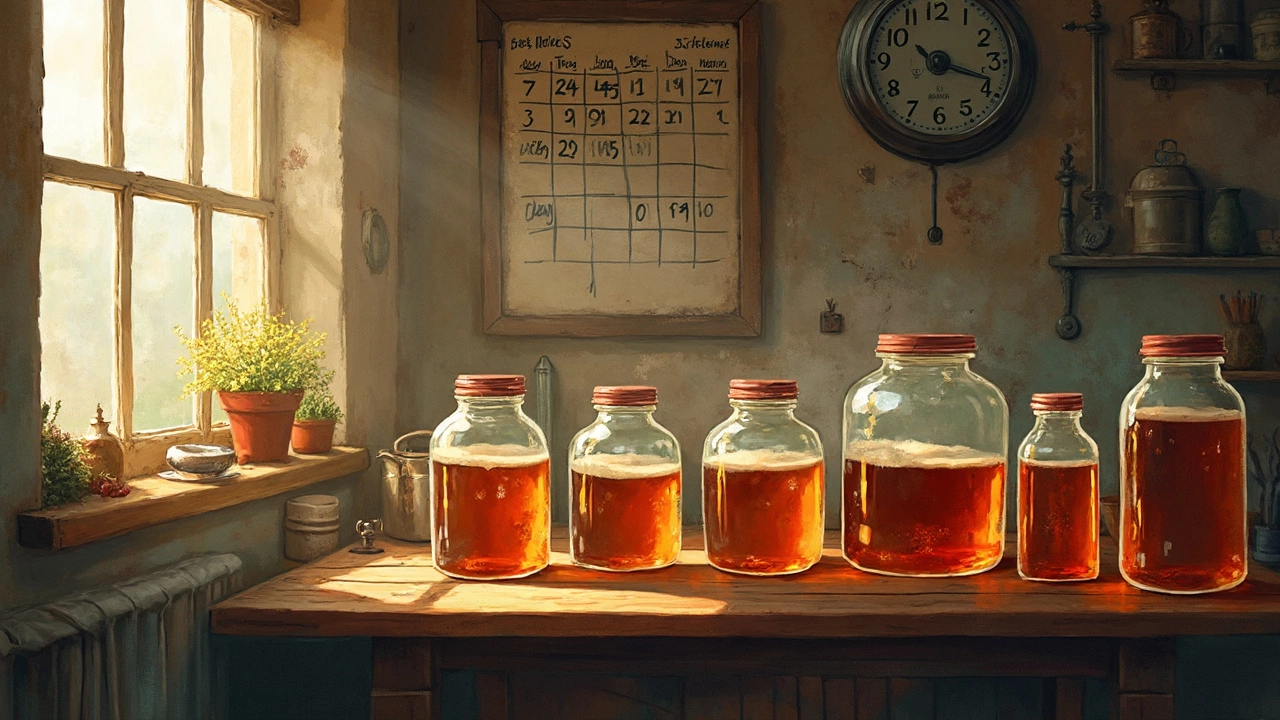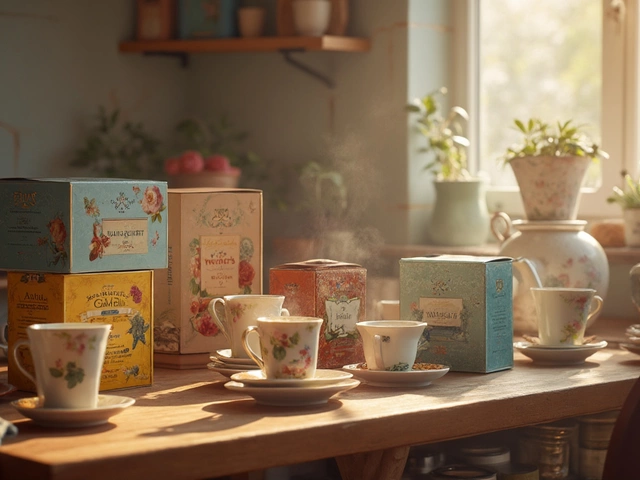So, you're standing there, gazing at your bubbling home brewing kit and wondering, 'Should I let this ferment a bit longer?' Well, you're not alone. It's a common question for anyone dabbling in home brewing. Letting beer ferment longer than the usual one or two weeks can bring some surprises.
First off, it's crucial to understand what's happening in there. Fermentation is when yeast gets busy converting sugars into alcohol and carbon dioxide, creating that beer magic we all love. Now, keeping it fermenting longer means more time for yeast to work its charm. Sometimes, this results in deeper flavors and clarity. But it's not all about patience. Too long could lead to off-flavors or even spoilage.
- Understanding Fermentation
- The Role of Yeast
- Effects of Extended Fermentation
- Potential Risks
- When to Taste Test
- Final Thoughts on Timing
Understanding Fermentation
Alright, let's get into the nitty-gritty of what exactly happens during beer fermentation. This magical process is all about turning sugars into alcohol, thanks to the little workhorses called yeast. When you mix your ingredients, you've got what home brewers call 'wort'—a sweet, sticky liquid just begging to transform into beer.
The moment you add yeast to the game, the real fun starts. These microorganisms consume the sugars found in the wort and produce alcohol and carbon dioxide. And voilà, you're making beer in that cozy home brewing kit of yours!
Primary and Secondary Fermentation
In the world of home brewing, fermentation happens in two stages. First, there's primary fermentation, where most of the sugar conversion takes place. This usually lasts about a week. By the end of it, the yeast has created a pretty good amount of alcohol and made your wort bubbly.
Next up is secondary fermentation, which is a bit like the beer's aging process. Here, the fermentation time might vary anywhere from a couple of weeks to even months, depending on the type of beer. During this stage, the beer clarifies, and subtle flavors develop. But only if you're patient!
Why Timing Matters
Timing is everything in home brewing. If you rush it, you risk missing out on flavor complexity and a smoother finish. But go too long, and things might get too funky, with yeast or bacteria taking over more than you want. That's where the art of tasting and testing your brew comes in.
| Fermentation Stage | Duration | Main Activity |
|---|---|---|
| Primary | 1-2 weeks | Sugar conversion to alcohol |
| Secondary | 2+ weeks | Flavor development |
In essence, understanding these stages helps you decide the best moment to enjoy your creation. A little know-how and patience could turn your home-brewed beer from good to legendary.
The Role of Yeast
If you’re into home brewing, yeast is like your best buddy in the whole process. This microscopic fungus is what turns sugars into alcohol and gives beer its kick. But the secret sauce doesn’t stop there—yeast plays a massive role in developing the taste and character of your brew.
Yeast's Main Job
So why is yeast so crucial? Aside from making alcohol, it contributes to the aroma and flavor profile. Different yeast strains bring out different notes. Some give fruity vibes, while others make it more like freshly baked bread. That’s why picking the right yeast for your beer style is super important.
How Fermentation Works
In every brewing process, yeast is the engine. During fermentation, yeast cells gobble up sugars and spit out alcohol and CO2. But it doesn’t stop there; it also cleans up unwanted byproducts created during brewing. That’s why even after the initial stages, yeast still matters.
A Little Longer Isn’t Always Bad
Extending fermentation can sometimes help with clarity and flavor refinement. Yeast settles out the beer—this process is called flocculation. Longer times can let yeast cleanse the beer of flavors you don’t want in your final glass.
| Yeast Strain | Flavor Profile |
|---|---|
| Ale Yeast | Fruity, Spicy |
| Lager Yeast | Clean, Crisp |
So next time you’re caught up wondering about extending the time, remember what yeast is doing. Of course, there’s always a risk of leaving it too long—you could invite unwanted flavors or even spoil your brew. But keeping tabs on it can ensure your extended effort pays off.
Effects of Extended Fermentation
Letting your brew sit longer can bring noticeable changes to your beer fermentation process. One of the first impacts is on the taste, which can become richer and more complex due to the prolonged activity of the yeast.
Flavor Development
Extending fermentation time can allow secondary fermentation to really shine. During this period, leftover sugars are further consumed, producing subtle changes in taste. Think of it as letting spaghetti sauce simmer—it just gets better, right?
Flavor-wise, extended fermentation might bring out more maltiness or hops aroma, depending on what you've brewed. Some makers describe traces of fruitiness or different notes that weren't there earlier.
Alcohol Content
Will your brew get stronger the longer it ferments? Yes, but only to a point. Alcohol levels rise slightly as yeast continues converting sugars. However, it's not a drastic change, as most conversions are done within the first week or so.
Clarity and Carbonation
Patience is key for clearer beers. With more time, yeast and other particles settle at the bottom, leaving you with a cleaner look. If clarity is important to you, a little patience can make a difference.
Carbonation might slightly increase too, given extended time, as the CO2 generated has more time to dissolve, offering a potentially better fizz.
Potential Downsides
But hold your horses, it’s not all positives. Too much extra time might lead to off-flavors. Over-fermented beer can sometimes taste like cardboard or give off a 'yeasty' smell.
If your environment isn't sanitary, the longer wait could introduce spoilage or wild bacteria. So keep everything as clean as a whistle!

Potential Risks
While letting your brew ferment a bit longer can sometimes do wonders, we're not exactly dealing with foolproof magic here. There are a few potential hiccups to watch out for when extending the fermentation period.
Yeast Autolysis
One of the more alarming risks is something called yeast autolysis. This is a fancy way of saying that the yeast cells can start breaking down if left in the fermenter too long. This often leads to off-flavors, with some describing it as meaty or rubbery. It's like that leftovers smell when they've overstayed their welcome in the fridge.
Infection Risks
Extra time in the fermenter means more time for unwanted bacteria and wild yeast to crash the party. If sanitation isn't spot on, these little invaders can throw a wrench in your beer's taste. Always double-check that your home brewing kit is clean and properly sealed.
Over-Carbonation
This might be a lesser-known issue, but it's worth mentioning. If you're fermenting longer with the cap sealed tight, you risk over-carbonation. It can lead to excess pressure and potentially a messy explosion when you finally open the bottle.
Possible Solutions
- Beer fermentation is typically safest when monitored closely. Consider getting a hydrometer to check the gravity and see if fermentation is complete before extending time.
- If you're pushing the limits, rack the beer on time to avoid autolysis. Transferring your brew to a secondary fermenter can help separate the beer from dead yeast.
- Always maintain good sanitation practices to minimize infection risks.
So, while letting your home brewing enjoy a longer ferment might enhance your beer in some cases, remember it's all about balance and timing. Don't get too carried away with the waiting game!
When to Taste Test
Taste testing can be a bit nerve-racking, can't it? But it doesn't have to be. Knowing the right time to sample your brew can save you from a lot of guesswork. Generally, many home brewers recommend waiting at least a week or two before taking that first sip. This gives the yeast enough time to do their job.
But how do you really know it's time to taste test? A great rule of thumb is to keep an eye on the bubbles. If they're coming to a halt, it might be a good sign that fermentation is around its final stage. Use your hydrometer to check the specific gravity. If it's stayed stable for a couple of days, you're probably good to go.
Steps to Make That First Sip Count
- Sanitize your tools: Before doing anything, make sure your tools are squeaky clean to avoid contamination.
- Use the hydrometer: Check the gravity and ensure it aligns with your recipe's expected range.
- Pours and pause: Pour a small sample into a clean glass and let it settle for a minute or two.
- Observe first: Take a look at the color and clarity. A longer fermentation might clear up the brew.
- Smell and savor: Give it a good sniff. Are there any unexpected aromas? Then, take a sip and note the flavors.
Sometimes, if your brew's gravity isn't quite right or the taste isn't what you expected, waiting a few more days can help. Yeast can still adjust some of those flavors we're aiming for. Just remember, taste testing is part art, part science, and a dash of patience. Trust your senses and enjoy the process.
Final Thoughts on Timing
When it comes to how long you should let your beer ferment in your home brewing kits, there's a bit of a balancing act. On the one hand, more time can allow complex flavors to develop, especially with certain styles like stouts and lagers. But the key is not to push it too far. Too much time and you risk your batch developing unwanted flavors or worse, turning sour.
Here's a handy tip: Start with the basics. Ales typically take about two weeks to complete primary fermentation. Lagers might need twice that due to their cooler fermentation process. Always check the gravity if you can, with a hydrometer or a refractometer, to see if fermentation has stalled or ended. The target here is to get a constant gravity reading over a few days.
Listen to Your Beer
It might sound strange, but paying attention to the bubbles can be very telling. When you notice a significant slowdown in the airlock activity, it’s a good sign that initial fermentation is almost done. This is when you should consider whether you’re aiming for more aging to improve taste or if it's time for bottling.
- Do a taste test (just make sure everything is sanitized before taking a sample).
- Take notes on the taste and aroma.
- Decide if you should leave it a bit longer based on those notes.
In short, trust your instincts but back them up with some data from your equipment. Balancing the science and art of brewing is half the fun, and experimenting while sticking to guidelines can lead to a successful brew. Remember, every batch is practice for the next. Cheers to your brewing adventures!


